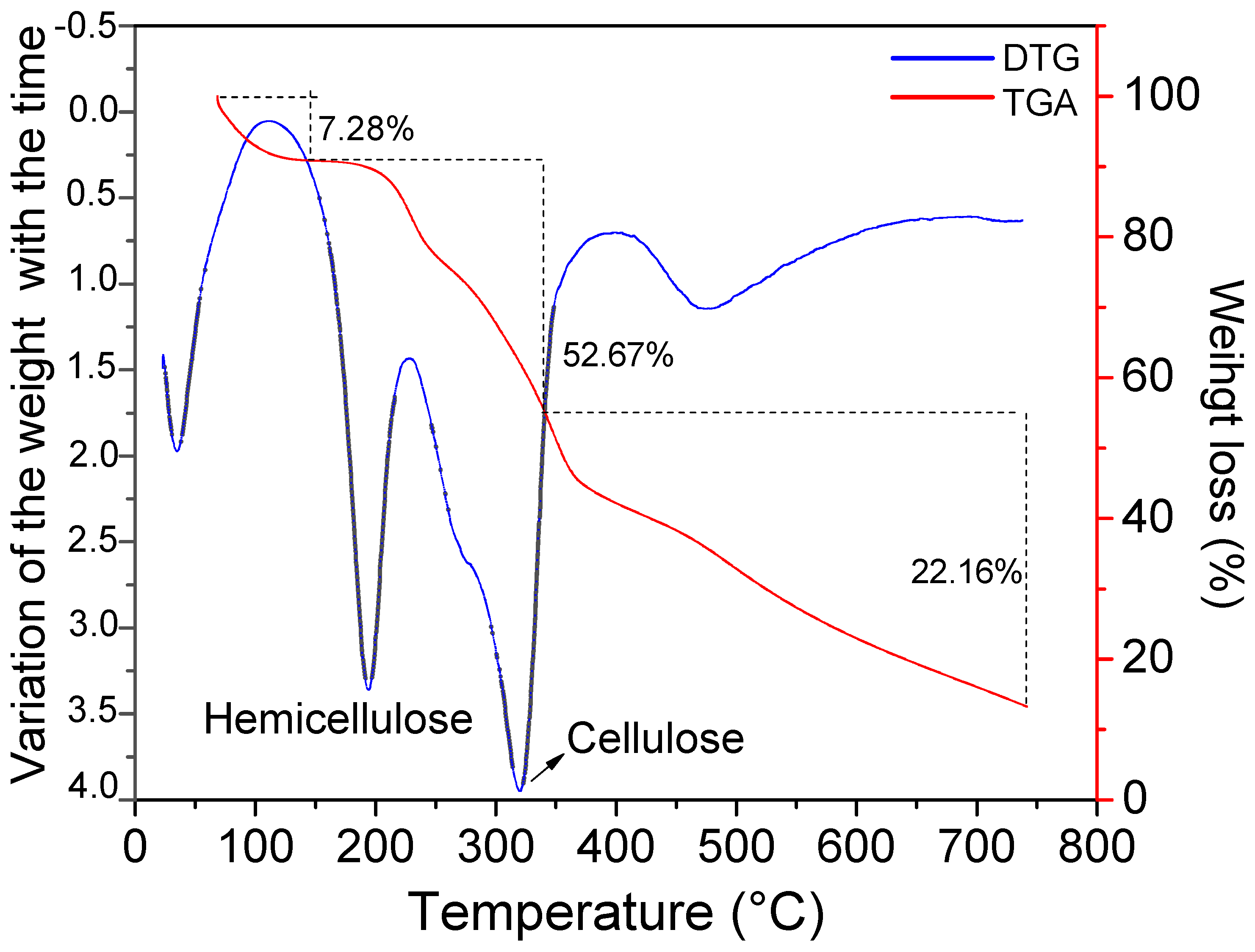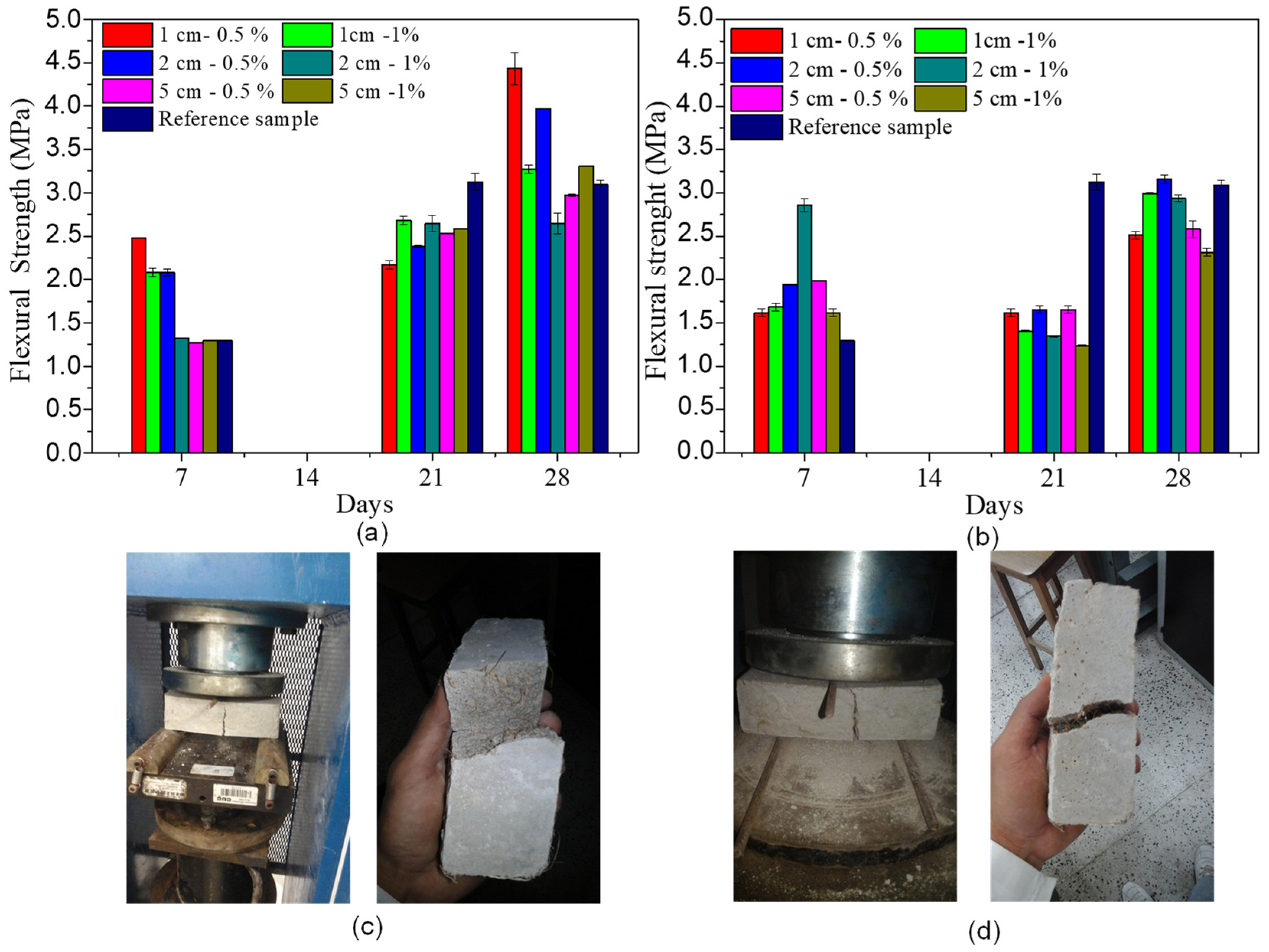Development of Structural Type Mortars Reinforced with Coconut (Cocos Nucifera) Fiber: Chemical, Thermal, and Mechanical Behavior
Abstract
1. Introduction
2. Materials and Methods
2.1. Fabrication of the Mortar
2.2. Preparation and Conditioning of the Fibers
2.3. Physicochemical Characterization of Fibers
2.4. Mechanical Characterization
3. Results and Discussion
3.1. Physicochemical Characterization of Fibers
3.1.1. Chemical Resistance
3.1.2. Thermal Analysis
3.2. Mechanical Evaluation
3.2.1. Compressive Strength
3.2.2. Flexural Strength
4. Conclusions
Author Contributions
Funding
Data Availability Statement
Conflicts of Interest
References
- Thanushan, K.; Sathiparan, N. Mechanical performance and durability of banana fibre and coconut coir reinforced cement stabilized soil blocks. Materialia 2022, 21, 101309. [Google Scholar] [CrossRef]
- Agopyan, V.; Savastano, H., Jr.; John, V.; Cincotto, M. Developments on vegetable fibre-cement based materials in São Paulo, Brazil: An overview. Cem. Concr. Compos. 2005, 27, 527–536. [Google Scholar] [CrossRef]
- Varghese, A.; Unnikrishnan, S. Mechanical strength of coconut fiber reinforced concrete. Mater. Today Proc. 2023. [Google Scholar] [CrossRef]
- Zou, Q.; Ye, X.; Huang, X.; Zhang, W.; Zhang, L. Influence of elevated temperature on the interfacial adhesion properties of cement composites reinforced with recycled coconut fiber. J. Build. Eng. 2014, 98, 111270. [Google Scholar] [CrossRef]
- Crucho, J.M.L.; de Picado-Santos, L.G.; das Neves, J.M.C. Assessment of the durability of cement-bound granular mixtures using reclaimed concrete aggregate and coconut fiber. Constr. Build. Mater. 2024, 441, 137550. [Google Scholar] [CrossRef]
- Osoriosaraz, J.A.; Varón Aristizabal, F.; Herrera Mejía, J.A. Comportamiento mecánico del concreto reforzado con fibras de bagazo de caña de azúcar. Dyna 2007, 74, 69–79. [Google Scholar]
- Coutts, R.S.P. A review of Australian research into natural fibre cement composites. Nat. Fibre. Reinf. Cem. Compos. 2005, 27, 518–526. [Google Scholar] [CrossRef]
- Bentur, A.; Sidney, M. Fibre Reinforced Cementitious Composites; CRC Press: Boca Raton, FL, USA, 2014. [Google Scholar]
- de Guzman, D.S. Tecnología del Concreto y del Mortero; Bhandar Editores LTDA: Bogota, Colombia, 2001. [Google Scholar]
- Llerena Encalada, A. Estudio de Compuestos Cementicios Reforzados con Fibras Vegetales. Master’s Thesis, Universitat Politècnica de Catalunya, Barcelona, Spain, 2014. [Google Scholar]
- NTC 3546; Norma Técnica Colombiana. Concretos. Métodos de Ensayo para Determinar la Evaluación en el Laboratorio y en obra, de Morteros para Unidades de Mampostería Simple y Reforzada. ICONTEC: Bogota, Colombia, 2003.
- I.N.V.E-324-07; Resistencia a la Flexión de Morteros de Cemento Hidraúlico. Instituto Nacional de Vías: Bogota, Colombia, 2007.
- Acevedeo de la Espriella, M.A.; Luna Velasco, M.S. Tratamiento Químicos Superficiales para el Uso de Fibras Naturales en la Construccioón: Concretos y Morteros; Monografia Título Ingeniero Civil; Universidad de Cartagena: Bolivar, Colombia, 2021. [Google Scholar]
- Juarez Alvarado, C.A. Concretos Base Cemento Portland Reforzados con Fibras Naturales (Agave lechugilla), Como Materiales para Construcción en México. Ph.D. Thesis, Universidad Autónoma de Nuevo León, St. Nicholas, Mexico, 2002. [Google Scholar]
- Bilba, K.; Arsene, M.-A.; Ouensanga, A. Study of banana and coconut fibers: Botanical composition, thermal degradation and textural observations. Bioresour. Technol. 2007, 98, 58–68. [Google Scholar] [CrossRef]
- Hernandez-Vidal, N.; Bautista, V.; Morales, V.; Ordóñez, W.; Osorio, E. Caracterización química de la Fibra de Coco (Cocus nucifera L.) de México utilizando Espectroscopía de Infrarrojo (FTIR). Ing. Región 2018, 20, 67–71. [Google Scholar] [CrossRef]
- Ceron Meneses, Y.P.; Alban Bolaños, P.; Grass Ramírez, J.F.; Camacho Muñoz, R. Caracterización física, química, térmica y mecánica de fibras de coco de la Costa Pacífica del Cauca con potencial como refuerzo de materiales compuestos de matriz polimérica. Biotecnol. Sect. Agropecu. Agroind. 2024, 22, 30–42. [Google Scholar]
- Contreras, J.; Trujillo, A.; Arias, O.; Perez, L.J.B.; Delgado, F.E. Espectroscopía ATR-FTIR de celulosa: Aspecto instrumental y tratamiento matemático de espectros. e-Gnosis 2010, 8, 1–13. [Google Scholar]
- Paola, R.; Valladares, S.; Pedro, O.; Gáscue, B.; Peña, G. Obtención de Celulosa Microcristalina a partir de Desechos Agrícolas del Cambur (Musa sapientum). Síntesis de Celulosa Microcristalina. Rev. Iberoam. Polímeros 2014, 15, 286–300. [Google Scholar]
- Luo, Z.; Li, P.; Cai, D.; Chen, Q.; Qin, P.; Tan, T.; Cao, H. Comparison of performances of corn fiber plastic composites made from different parts of corn stalk. Ind. Crops Prod. 2017, 95, 521–527. [Google Scholar] [CrossRef]
- Sanou, I.; Bamogo, H.; Sory, N.; Gansoré, A.; Millogo, Y. Effect of the coconut fibers and cement on the physico-mechanical and thermal properties of adobe blocks. Heliyon 2024, 10, e38752. [Google Scholar] [CrossRef] [PubMed]
- Olonade, K.A.; Savastano Junior, H. Performance evaluation of treated coconut fibre in cementitious system. SN Appl. Sci 2023, 5, 218. [Google Scholar] [CrossRef]
- Carrillo Navarrete, F. Caracterización Estructural de Fibras Lyocell y su Comportamiento Frente a Procesos de Degradación. Ph.D. Thesis, Universitat Politècnica de Catalunya, Barcelona, Spain, 2002. [Google Scholar]
- Ssemujju Lubowa, P.; Ndiritu, H.; Oketch, P.; Mutua, J. Coconut Fiber Pyrolysis: Bio-Oil Characterization for Potential Application as an Alternative Energy Source and Production of Bio-Degradable Plastics. World J. Eng. Technol. 2024, 12, 310–319. [Google Scholar] [CrossRef]
- Paricaguán, B.; Albano, C.; Palacios, J.; Torres, R.; Camacho, N.; Infante, J.; Alvarado, M. Degradación térmica de fibras de coco con tratamiento químico provenientes de mezclas de concreto (estudio cinético). Rev. Ing. UC 2013, 20, 60–67. [Google Scholar]
- Pineda Gomez, P.; Coral, D.F.; Rivera Ramos, D.; Rosales Rivera, A. Estudio de las propiedades térmicas de harinas de maíz producidas por tratamiento térmico-alcalino. Ing. Cienc. 2011, 7, 119–142. [Google Scholar]
- Ferreira, S.R.; de Andrade Silva, F.; Lima, P.R.L.; Toledo Filho, R.D. Effect of fiber treatments on the sisal fiber properties and fiber–matrix bond in cement based systems. Constr. Build. Mater. 2015, 101, 730–740. [Google Scholar] [CrossRef]
- Wei, J.; Meyer, C. Degradation rate of natural fiber in cement composites exposed to various accelerated aging environment conditions. Corros. Sci. 2014, 88, 118–132. [Google Scholar] [CrossRef]
- Jimenez, A.; Betancourt, S.; Gañán, P.; Cruz, L. Degradación térmica de fibras naturales procedentes de la calceta de plátano. (Estudio cinético). Rev. Latinoam. Metal. Mater. 2009, 29, 215–219. [Google Scholar]
- Juarez, C.; Valdes, P.; Durán, A. Fibras naturales de lechuguilla como refuerzo en materiales de construcción. Rev. Ing. Construcción 2004, 19, 83–92. [Google Scholar]
- Wei, J.; Meyer, C. Utilization of rice husk ash in green natural fiber-reinforced cement composites: Mitigating degradation of sisal fiber. Cem. Concr. Res. 2016, 81, 94–111. [Google Scholar] [CrossRef]
- Aziz, M.A.; Paramasivam, P.; Lee, S.L. Prospects for natural fibre reinforced concretes in construction. Int. J. Cem. Compos. Lightweight Concr. 1981, 3, 123–132. [Google Scholar] [CrossRef]
- Chakraborty, S.; Kundu, S.P.; Roy, A.; Adhikari, B.; Majumder, S.B. Polymer modified jute fibre as reinforcing agent controlling the physical and mechanical characteristics of cement mortar. Constr. Build. Mater. 2024, 49, 214–222. [Google Scholar] [CrossRef]
- Fujiyama, R.; Darwish, F.; Pereira, M.V. Mechanical characterization of sisal reinforced cement mortar. Theor. Appl. Mech. Lett 2014, 4, 061002. [Google Scholar] [CrossRef]
- Lorensia, L.; Hou, T. Effects of boiling and fiber length on the resistivity of coconut-fiber-reinforced mortar. Case Stud. Constr. Mat. 2024, 20, e03177. [Google Scholar] [CrossRef]
- Yan, L.; Kasal, B.; Huang, L. A review of recent research on the use of cellulosic fibres, their fibre fabric reinforced cementitious, geo-polymer and polymer composites in civil engineering. Compos. Part B Eng 2016, 92, 94–132. [Google Scholar] [CrossRef]
- Hwang, C.-L.; Tran, V.-A.; Hong, J.-W.; Hsieh, Y.-C. Effects of short coconut fiber on the mechanical properties, plastic cracking behavior, and impact resistance of cementitious composites. Constr. Build. Mater. 2016, 127, 984–992. [Google Scholar] [CrossRef]
- Quintero García, S.L.; González Salcedo, L.O. Uso de fibra de estopa de coco para mejorar las propiedades mecánicas del concreto. Ing. Desarro. 2011, 20, 134–150. [Google Scholar]
- Gonzalez Salcedo, L.O. Influencia de los Componentes del Concreto Reforzado con Fibras en sus Propiedades Mecánicas; Universidad Nacional De Colombia: Palmira, Colombia, 2013. [Google Scholar]








| Fiber Type | Protective Substance | Length (cm) | Percentage by Weight | Number of Specimens |
| Coconut fiber | Linseed oil | 1 | 0.5 | 12 |
| 1 | 12 | |||
| 2 | 0.5 | 12 | ||
| 1 | 12 | |||
| 5 | 0.5 | 12 | ||
| 1 | 12 | |||
| Paraffin wax | 1 | 0.5 | 12 | |
| 1 | 12 | |||
| 2 | 0.5 | 12 | ||
| 1 | 12 | |||
| 5 | 0.5 | 12 | ||
| 1 | 12 | |||
| Control mortar | 6 | |||
| Total | 150 | |||
Disclaimer/Publisher’s Note: The statements, opinions and data contained in all publications are solely those of the individual author(s) and contributor(s) and not of MDPI and/or the editor(s). MDPI and/or the editor(s) disclaim responsibility for any injury to people or property resulting from any ideas, methods, instructions or products referred to in the content. |
© 2025 by the authors. Licensee MDPI, Basel, Switzerland. This article is an open access article distributed under the terms and conditions of the Creative Commons Attribution (CC BY) license (https://creativecommons.org/licenses/by/4.0/).
Share and Cite
Monsalve-Arias, M.-J.; Higuera-Cobos, O.-F.; Pedraza-Yepes, C.-A. Development of Structural Type Mortars Reinforced with Coconut (Cocos Nucifera) Fiber: Chemical, Thermal, and Mechanical Behavior. J. Compos. Sci. 2025, 9, 300. https://doi.org/10.3390/jcs9060300
Monsalve-Arias M-J, Higuera-Cobos O-F, Pedraza-Yepes C-A. Development of Structural Type Mortars Reinforced with Coconut (Cocos Nucifera) Fiber: Chemical, Thermal, and Mechanical Behavior. Journal of Composites Science. 2025; 9(6):300. https://doi.org/10.3390/jcs9060300
Chicago/Turabian StyleMonsalve-Arias, Mónica-Johanna, Oscar-Fabián Higuera-Cobos, and Cristian-Antonio Pedraza-Yepes. 2025. "Development of Structural Type Mortars Reinforced with Coconut (Cocos Nucifera) Fiber: Chemical, Thermal, and Mechanical Behavior" Journal of Composites Science 9, no. 6: 300. https://doi.org/10.3390/jcs9060300
APA StyleMonsalve-Arias, M.-J., Higuera-Cobos, O.-F., & Pedraza-Yepes, C.-A. (2025). Development of Structural Type Mortars Reinforced with Coconut (Cocos Nucifera) Fiber: Chemical, Thermal, and Mechanical Behavior. Journal of Composites Science, 9(6), 300. https://doi.org/10.3390/jcs9060300






